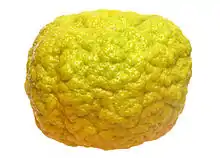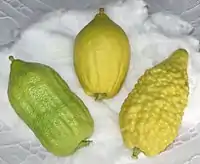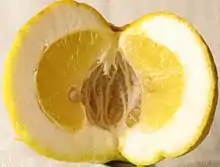Pompia
Pompia (Citrus medica tuberosa Risso & Poiteau) is a Citrus hybrid cultivated for its edible fruit.[1]
| Pompia | |
|---|---|
 | |
| Pompia fruit | |
| Scientific classification | |
| Kingdom: | Plantae |
| Clade: | Tracheophytes |
| Clade: | Angiosperms |
| Clade: | Eudicots |
| Clade: | Rosids |
| Order: | Sapindales |
| Family: | Rutaceae |
| Genus: | Citrus |
| Species: | C. m. tuberosa |
| Binomial name | |
| Citrus medica tuberosa | |
| Synonyms | |
| |
| Citron varieties |
|---|
 |
| Acidic-pulp varieties |
| Non-acidic varieties |
| Pulpless varieties |
| Citron hybrids |
| Related articles |


Distribution
Pompia originated and is found only in Sardinia, especially the eastern half, where it can be found growing wild in citrus groves and cultivated in backyards or orchards.[2]
Description
The fruit is moderately large (at least as large as a grapefruit), round and sometimes oblate or square in shape, and has a rough, warty, yellow, thick, and sometimes ribbed rind. The inner pulp is acidic, yellow, and mostly dry and is generally considered inedible.[3] It has been described as bitter and chewy. It weighs up to 1.5 pounds (0.7 kilograms).
Uses
The fruit has been grown and cultivated for at least two centuries in Sardinia; however, it did not gain international popularity until the 1990s, when a large orchard of pompia trees were planted as part of a social farming project. Since then, it has been protected by the Slow Food Presidium.[4] It is most notably used in Sa pompia Intrea, a traditional dessert of Siniscola in which the rind of the fruit is candied and then covered with honey and served on an orange leaf. It is also used in various liquors.[5]
Genetics
Before the parentage was confirmed, the pompia was thought to be a hybrid of a citron and grapefruit or citron and lemon; however, recent studies have proven the pompia to be a hybrid of the citron and the sour orange, with the citron being the pollinator and the sour orange being the receptor. The variety of citron has not been confirmed, but it is likely a Diamante citron or a common poncire. It is genetically synonymous with the Rhobs el Arsa and Poncire de Collioure citrons. The essential oil composition in the leaf is closer to that of a citron, while the EO composition in the zest is closer to that of a sour orange.[6] The major compound in the fruit is limonene at 94%, and it contains smaller amounts of sesquiterpenes and its derivatives.[7] The rind of the fruit contains antioxidant substances[8] and the leaves contain antimicrobial substances that kill Listeria bacteria on foods.[9]
Taxonomy
The species was described by botanists Antoine Risso and Pierre Antoine Poiteau in 1818. It is treated as a synonym of Citrus limon (L.) Burm.f. in taxonomy.[10]
See also
References
- Luro, François; Viglietti, Grazia; Marchi, Elodie; Costantino, Gilles; Scarpa, Grazia Maria; Tomi, Felix; Paoli, Mathieu; Curk, Franck; Ollitrault, Patrick (1 December 2019). "Genetic, morphological and chemical investigations reveal the genetic origin of Pompia (C. medica tuberosa Risso & Poiteau) – An old endemic Sardinian citrus fruit". Phytochemistry. p. 112083. doi:10.1016/j.phytochem.2019.112083. Retrieved 26 January 2021.
- "Pompia - Presidi Slow Food". fondazioneslowfood.com. Retrieved 26 January 2021.
- "Pompia - Presìdi Slow Food". Slow Food Foundation. Retrieved 26 January 2021.
- "Pompia Citron". Oscar Tintori - Nurseries Worldwide - Citrus Plants. Retrieved 26 January 2021.
- "pompia citrus monstruosa". sandalyon.eu. Retrieved 26 January 2021.
- Luro, François; Viglietti, Grazia; Marchi, Elodie; Costantino, Gilles; Scarpa, Grazia Maria; Tomi, Felix; Paoli, Mathieu; Curk, Franck; Ollitrault, Patrick (1 December 2019). "Genetic, morphological and chemical investigations reveal the genetic origin of Pompia (C. medica tuberosa Risso & Poiteau) – An old endemic Sardinian citrus fruit". Phytochemistry. p. 112083. doi:10.1016/j.phytochem.2019.112083. Retrieved 26 January 2021.
- "The origins of pompia: An Italian citrus delicacy". Wiley Analytical Science. doi:10.1002/sepspec.152124807a4/full/. Retrieved 26 January 2021.
- Manconi, Maria; Manca, Maria Letizia; Marongiu, Francesca; Caddeo, Carla; Castangia, Ines; Petretto, Giacomo Luigi; Pintore, Giorgio; Sarais, Giorgia; D'hallewin, Guy; Zaru, Marco; Bacchetta, Gianluigi; Fadda, Anna Maria (15 June 2016). "Chemical characterization of Citrus limon var. pompia and incorporation in phospholipid vesicles for skin delivery". International Journal of Pharmaceutics. pp. 449–457. doi:10.1016/j.ijpharm.2016.04.014. Retrieved 26 January 2021.
- Fancello, Francesco; Petretto, Giacomo L.; Marceddu, Salvatore; Venditti, Tullio; Pintore, Giorgio; Zara, Giacomo; Mannazzu, Ilaria; Budroni, Marilena; Zara, Severino (May 2020). "Antimicrobial activity of gaseous Citrus limon var pompia leaf essential oil against Listeria monocytogenes on ricotta salata cheese". Food Microbiology. p. 103386. doi:10.1016/j.fm.2019.103386. Retrieved 26 January 2021.
- "Citrus limon var. pompia Camarda". www.gbif.org. Retrieved 26 January 2021.